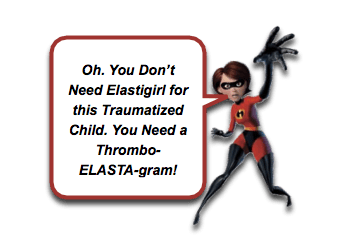Thromboelastagram and Trauma
 Trauma and accidental injuries keep us all quite busy in the Emergency Departments across the country. Unfortunately, despite advances in prevention, trauma is still the leading cause of mortality in children. Appropriately, we have discussed numerous topics pertaining to trauma (ex, Pneumothorax, Traumatic Aortic Injury, Major Brain Injury, Abdominal Trauma) and recently even touched upon the notion of Damage Control Resuscitation. One aspect of damage control resuscitation is the idea that coagulopathy is risk factor for mortality and, thus, it is important for us to understand a patient’s coagulation characteristics early on in management. Unfortunately, traditional PT/PTT and INR do not reveal the complete picture. Let’s look at a tool that may help us see that picture better – The Thromboelastagram:
Trauma and accidental injuries keep us all quite busy in the Emergency Departments across the country. Unfortunately, despite advances in prevention, trauma is still the leading cause of mortality in children. Appropriately, we have discussed numerous topics pertaining to trauma (ex, Pneumothorax, Traumatic Aortic Injury, Major Brain Injury, Abdominal Trauma) and recently even touched upon the notion of Damage Control Resuscitation. One aspect of damage control resuscitation is the idea that coagulopathy is risk factor for mortality and, thus, it is important for us to understand a patient’s coagulation characteristics early on in management. Unfortunately, traditional PT/PTT and INR do not reveal the complete picture. Let’s look at a tool that may help us see that picture better – The Thromboelastagram:
Coagulopathy and Trauma
- The “Terrible Triad of Trauma” = Hypothermia, Acidosis, and Coagulopathy
- Severe hemorrhage and large volumes of saline or packed RBCs exacerbate all three aspects of this terrible triad.
- Lots of isotonic fluids can dilute clotting factors, in addition to causing numerous other intracellular and extracellular chaos (increase inflammatory markers) complicating the patient’s physiologic status.
- Even pRBCs can cause coagulopathy.
- Acidosis and Coagulopathy are associated with requiring blood products. [Smith, 2016]
- Severe hemorrhage and large volumes of saline or packed RBCs exacerbate all three aspects of this terrible triad.
- Trauma, itself, can lead to coagulopathy.
- Patients who have had major trauma can arrive to the ED already having developed evidence of fibrinolysis and coagulopathies.
- This can be further exacerbated by our therapies (… like lots of saline).
- Early coagulopathy is associated with increased mortality in trauma patients (both adult and pediatric). [Strumwasser, 2016; Hendrickson, 2012; Talving, 2009; Niles, 2008; MacLeod, 2003]
- Damage Control Resuscitation aims to reduce this effect by empirically treating coagulopathy with balanced blood product transfusions (ie, massive transfusion protocols).
- It also focuses on using limited amounts of saline.
- The true efficacy of massive transfusion protocols in pediatric trauma patients is still debated and broad application to all severely injured children may not be beneficial. [Cannon, 2017]
- Empirically treating all severely injured may not be the best method to treat coagulopathy.
- It may be better to treat those who actually have it.
- But, PT/PTT and INR do not tell the whole story…
- Damage Control Resuscitation aims to reduce this effect by empirically treating coagulopathy with balanced blood product transfusions (ie, massive transfusion protocols).
Thromboelastogram for Trauma
- Thromboelastography (TEG) generates a Thromboelastogram [See below from Nylund, 2009].
- TEG is a rapid, point-of-care test. [Nylund, 2009]
- Traditional coagulation studies can take ~30-60 min to run.
- TEG can be complete in ~10 min.
- Point-of-care PT/PTT and INR tests do exist, but…
- TEG measures the ENTIRE coagulation cascade. [Nylund, 2009]
- It uses whole blood… PT/PTT and INR use just the plasma.
- PT/PTT only evaluate part of the coagulation cascade.
- PT/PTT does not evaluate the interaction between clotting factors and platelets.
- PT/PTT does not assess fibrinogen or platelet function.
- TEG is the only readily available test that assesses the fibrinolytic system.
- Thromoboelastograms generates a tracing that can help providers tailor therapies (like FFP and Platelets) to what an individual patient may require. [Nylund, 2009]
- Can identify the coagulopathic.
- Can identify the patient who may benefit from anti-fibrinolytic.
- Can identify the hypercoagulable patient also (which also can happen in the setting of trauma).
- Each segment (ex, r-time, MA) describe specific characteristics of the clotting process (see Nylund, 2009 for nice description).
Moral of the Morsel
- Clotting involves more than plasma. TEG can help you see the entire picture.
- Coming to an ED near you… The TEG will be a tool that we need to become familiar with.



What are The impacts of early thromboelastography directed therapy in trauma resuscitation.